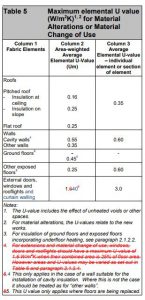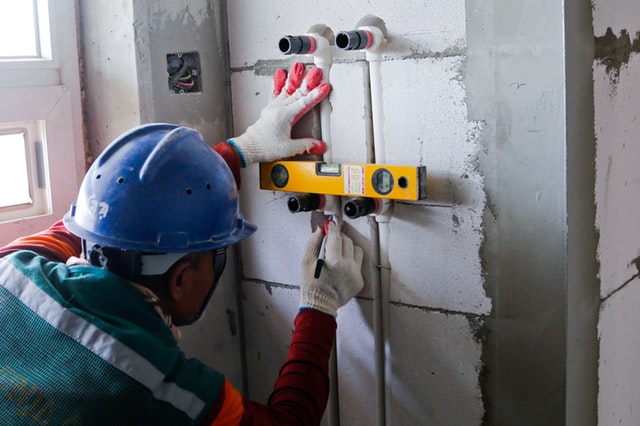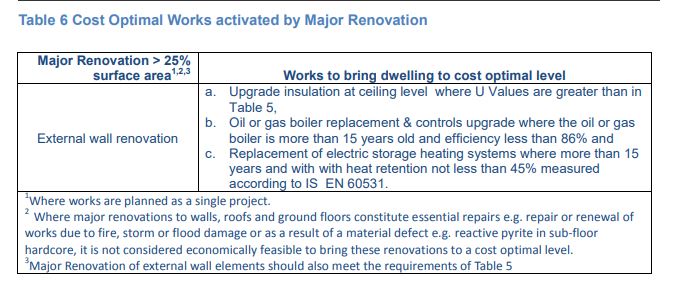The proposed changes to Parts L and F of the ROI Building Regulations were debated at the SEAI Energy Show’s Overcoming the challenges of NZEB and Major Renovation workshop on the 18th April 2018. Here are our findings.
- The updated Parts F and L of the building regulations are expected to take effect in April 2019, subject to a transition period. The transition period foresees that the previous regulations will continue to apply to those dwellings that have secured planning permission before April 2019 and that have built the house up to wall plate level by the 31st March 2020. The final version of the regulations, post public consultation, are expected to be published in July of this year with the revised Dwellings Energy Assessment Procedure (DEAP – the software used to calculate compliance with Part L of the building regulations) published in September.
- There is a focus in the draft regs on the importance of commissioning and on the need to provide the end-user with information about how the house works and how to maintain the building services, e.g. how and when to change filters in mechanical ventilation systems.
- “Design data” will be made available from Met Eireann, announced Minister English in his opening address, presumably to help designers specify the thermal envelope and the ventilation strategy*.
- Consultants AECOM claim that houses built to the draft Parts L and F present a minimal risk of overheating, which they say can readily be dealt with by making better use of curtains and blinds.
- Uplift in costs between the previous versions of the regulations and the current draft regulations is between 0.7 and 4.2 per cent, according to consultants Currie & Brown who did the cost analysis for AECOM.
Part L: Energy
- For new builds Part L 2018 versus Part L 2011 will see the Building Energy Rating go from an A3 to an A2.
- Backstop value for airtightness reduced from 7 to 5 m3 per hour per sqm at 50 Pa.
- U-values reduced from 0.21 W/sqmK for all building elements (walls, roof, floor) to 0.18 W/sqmK which implies 150mm cavity walls as the new standard.
- The draft Renewable Energy Requirement is envisaged to be increased to 20 per cent which means either a heat pump or gas boiler with PV panels will be the two cost optimal options open to self-builders. Renewables refer to heat pumps as well as biomass, solar photovoltaic (PV), solar thermal, CHP, and the renewable component of district heating, among others.
- Minimum U-values for windows and doors set at a strict 1.4 W/sqmK (removal of permitted variations) and even though this represents the best performing type of double glazing, triple glazing is envisaged in many of the ‘regs compliant’ scenarios the Department has published. The Department of Housing’s Sean Armstrong pointed to triple glazing likely to be required “in a lot of cases”.
- Space heating controls (zoning and time controller) requirement.
- As previously announced, for renovations of 25 per cent or more of the building, an energy upgrade of the house will have to take place to bring it to the cost optimal level of a B3 or in the case of an external wall renovation:

- The calculations in the revised DEAP will be more favourable to heat pump technology, according to the SEAI’s Orla Coyle. The draft DEAP also envisages penalising extensive artificial lighting strategies and plans to make provisions for dual heating systems (currently you must choose a primary heating system). Hot water calculations will be more fined tuned by taking into account things like flow restrictors on showers reducing hot water demand. Another proposal is for the Primary Energy Factor to no longer be updated on a yearly basis but be based on projections and renewed every three to five years.
- To achieve compliance there are two stages: overall compliance (that the building complies to nZEB calculations, equivalent to a 70 per cent reduction on 2005 requirements) and minimal threshold compliance (maxmium U-values, etc.). In addition, Construction Quality and Commissioning will have to be fulfilled as well as a document produced for the end-user’s information.
Part F: Ventilation
- The draft regulations make it mandatory that the ventilation system, whether natural or mechanical, be certified (validated and checked) by an independent third party (not the installer of the system), such as an airtightness tester. The biggest issue with ventilation, Armstrong said, was to do with incorrect design and commissioning, including incorrect installation and balancing.
- Ease of use is part of the requirement and this includes easy servicing, so best practice indicates that a mechanical unit must not be installed in an attic but instead in a place that’s easy to access to change the filters.
- Much more detailed guidelines are provided for all ventilation types, including for installation and commissioning.
- The draft Part F continues to allow for natural ventilation but only within a tight airtightness band of between 3 and 5 m3 per hour per sqm at 50 Pa. This means that the current requirements for natural ventilation under 5 m3 per hour per sqm at 50 Pa continue to apply (roughly achieved with 5 inch vents in every room). Any value below 3 requires mechanical ventilation as the whole house solution.
*UPDATE 19th April 2018 from the Dept of Housing in relation to the work of Met Eireann in supplying design data: “The National Standards Authority of Ireland, Met Eireann and Department of Housing Planning and Local Government supported by Department of Communications Climate Action and Environment have a working group in place to review appropriate meteorological data used in standards related to building design. The group is currently developing a scope of review which is expected to include a review of driving rain intensity data and development of climatic data related to estimating the effects of solar gain in buildings for Ireland. It is proposed that the output of this review will include consideration of appropriate meteorological data which is affected by climate change as outlined in the National Adaptation Framework.”
*UPDATE 14th December 2018 from the Dept of Housing: On the 4th of December Part L was to be signed by the Minister for Housing “in the coming weeks”. Part F public consultation comments are currently undergoing review and it is planned for publication early in 2019.
*UPDATE 20th March 2019 from the Dept of Housing: Part L and Part F are expected to be published in the third quarter of this year – September seems to be the earliest we can expect publication.
*UPDATE 28th March 2019 The new building regulations are expected to be signed into law on April 19th, Sean Armstrong of the Department of Housing announced at the SEAI Energy Show
The new ROI energy regulations in the form of Part L (energy) and Part F (ventilation) are to come into force in November with a transitional arrangement for those who get planning permission on or before the 31st of October 2019.
The final versions of Parts L and F weren’t published but according to Armstrong there aren’t any substantial changes to what was published in the draft regulations last year. The main change has to do with the addition of two tables to give examples and to further explain what 25 per cent of the surface area of a dwelling means. In other words, provide guidance so that designers know which renovation or extension projects will have to invest in a B2 upgrade.
Some of the participants at the Energy Show voiced concerns that the 25 per cent rule would be hard to police but there are no plans to change the building control structure to enforce the regulations. The good news is the National Standards Authority of Ireland is further developing standards for heat pumps and for a ventilation validation scheme.
The full updated DEAP software that’s used to do the calculations for Part L is expected to be released this summer.
*UPDATE 16th May 2019: The Energy Performance of Building Regulations SI 183 of 2019 were published in the Iris Oifigiúil of May 3rd 2019. According to the Department of Housing the technical guidance documents (TGD) will be published on their website “shortly”. The Regulations will come into operation on 1 November 2019.
*UPDATE 2nd July 2019: The final 2019 verstion of Part L along with DEAP annexes are now available on the Department of Housing website.
Part F is available here along with the commissioning document.
*UPDATE 18th September 2019:
Transition period: Part L of 2011 and Part F of 2009 can continue to be used in the following cases:
- where the works or the change of use commences or takes place, as the case may be, on or before 31st October 2019
- planning approval or permission has been applied for on or before 31st October 2019, and substantial work has been completed by 1st November 2020 or;
a notice pursuant to the provisions of Part 8 of the Planning and Development Regulations 2001 (S.I. No. 600 of 2001), has been published on or before 31st October 2019, and substantial work has been completed by 1st November 2020.
“Substantial work has been completed” means that the structure of the external walls has been erected.
Selfbuild sought clarification from the Department of Housing in relation to the requirement around planning approval or permission; the Department’s reply:
The wording “planning approval or permission has been applied for on or before 31st October 2019” means any planning applications received and date stamped by the planning authority on or before 31 October 2019.
The Department added:
“It should also be noted that any planning applications which are subsequently found to be invalid because they do not comply with the relevant requirements of the Planning and Development Regulations 2001, as amended, will be returned to the applicant stating that the application is invalid and why.”
“The primary responsibility for compliance with the requirements of the Building Regulations rests with the designers, builders and owners of buildings. Interpretation of the legislation is, ultimately, a matter for the Courts and implementation of the Building Control system is a matter for the local Building Control Authority.”
“This Department has no function in assessing whether any particular proposal complies with the Building Regulations. Enforcement of the Building Regulations is a matter for the local Building Control Authority.”
*UPDATE 27th September 2019: The Department of Housing explained to reporters at a briefing on the 25th September that, in the update to Part L relating to Major Renovations:
- The 25 per cent value calculation is applicable to the building envelope of the existing house, namely existing ground floor, existing walls and existing roof.
- Extensions are unlikely to trigger the 25 per cent threshold which would require the entire building to be upgraded to a B2. Unless two of the walls were to be altered because of the extension, it’s unlikely the 25 per cent threshold would be triggered. See next UPDATE below which implies that in the case of terraced houses and some end of terrace houses, extensions could trigger the 25 per cent threshold.
- Upgrading the building fabric is however likely to trigger the 25 per cent threshold, e.g. insulating all of the walls of a property. In that case, the Department argues, the additional cost of upgrading the entire house to a B2 could simply involve the addition of insulation in the roof and of heating controls, for example, which would only marginally add to the cost. Each house is unique and needs to be analysed on its own merits.
The Department added that a typical A-rated 3-bedroom semi-detached house is likely to be approximately €800 a year cheaper to heat than a similar house built before 2005.
For more about whether or not an extension would trigger the 25 per cent threshold see this analysis by architect Daniel Coyle.
*UPDATE 8th October 2019: The “major renovations” aspect could add €3,000 to €5,000 to planned major renovation works, according to a Department of Housing, Planning and Local Government briefing at Leinster House in September. This would be for a scenario whereby you’ve decided to insulate all of your walls, which typically triggers the 25 per cent of the surface area requirement to bring the entire dwelling to a BER of B2 or equivalent. You’d now need to carry out additional works to the home to comply with the regulations in the form of installing insulation at ceiling level and upgrading old and inefficient heating systems. However each case will be unique and the additional costs incurred will depend on the house itself, including age, location and condition, as well as the type of work you plan to carry out in the first place.
Q&A with the Department of Housing:
What happens if you undertake renovations in stages – add an extension one year, then External Wall Insulation a year later? Is the 25 per cent rule aggregated over time?
Table 7 in TGD L 2019 describes cost optimal works activated by Major Renovation where works are planned as a single project. Therefore the 25 per cent rule is not aggregated over time.
Is it correct not to include the two party walls in the envelope calculations? In the case of a mid-terrace house – an extension covering the whole rear wall could be 25 per cent of building’s envelope (heated surface area) – as the two side walls are not included in overall surface area / heated envelope.
Par. 0.5 of TGD L 2019 provides the definition of Major Renovation: means the renovation of a building where more than 25 per cent of the surface of the building envelope undergoes renovation.
The surface area of the building thermal envelope means the entire surface area of a building through which it can lose heat to the external environment or the ground, including all heat loss areas of walls, windows, floors and roof. The surface area should be calculated as outlined in section 0.4 using internal dimensions.
In the case of a terraced dwelling party walls are not heat loss walls and are not included in this calculation.









